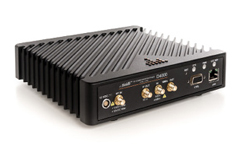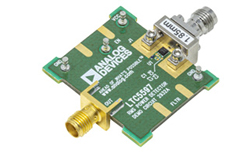
Today’s communication standards, such as 5G, are using higher frequencies and wider bandwidths. To support testing these new wireless standards, the thinkRF™ D4000 RF Downconverter/Tuner extends the performance of lower frequency RF test equipment to 40 GHz. Using thinkRF’s tuner technology, the D4000 is the industry’s first 40 GHz RF down-converter and tuner. The high performance, plug-and-play, portable platform enables mobile operators and system integrators to use existing field, lab and manufacturing test equipment, which extends the life of their investments while reducing the time to market for the new generation of 5G systems.
The D4000 covers 24 to 40 GHz - the currently defined FR2 bands for 5G - with 500 MHz of analog bandwidth. It has a single IF output, enabling easy integration with lower frequency spectrum analyzers and receivers, and the built-in local oscillator eliminates the need for an external synthesizer. Sophisticated pre-select filtering rejects out-of-band signals and reduces spurs which could interfere with the “real” signals within the analysis band.
Multiple D4000 units can be synchronized to create a compound signal monitoring system, particularly when more than 500 MHz instantaneous bandwidth must be monitored. 10 MHz input and output clock references enable clock synchronization with external equipment. Using complementary thinkRF receivers, a monitoring system can be extended to cover lower frequencies, such as the sub-6 GHz 5G bands.
The D4000 is controlled with standard configuration protocols using SCPI commands over an Ethernet interface. The size of the unit is 7.6 in. x 7.6 in. x 1.6 in., and it weighs 3.7 lbs. — making the D4000 RF Downconverter/Tuner portable, as well as versatile and easy to use.
thinkRF
Ottawa, Canada
www.thinkrf.com
MWJOURNAL.COM n OCTOBER 2020

70 GHz Linear-in-dB
RMS Power Detector

The LTC®5597 is a high accuracy RMS power detector that provides a very wide RF input bandwidth, from 100 MHz up to 70 GHz. This makes the device suitable for a wide range of RF and microwave applications, such as point-to-point microwave links, SATCOM, instrumentation, military radio, Wi-Fi, LTE/5G and power control applications.
The DC output voltage of the detector is an accurate representation of the average signal power applied to the RF input, independent of input waveforms with different crest factors such as CW, WCDMA and OFDM (LTE and Wi-Fi) signals. The response is linear-in-dB with 28.5 mV/dB logarithmic slope over a 35 dB dynamic range with typically better than ±1 dB accuracy.
The LTC5597 can measure signals down to -37 dBm, about 10 dB better than any Schottky device which can save the expense of an amplifier in the signal path. It has ±2 dB flat frequency response up to 60 GHz, enables accurate measurement of very broadband signals and minimizes need for calibration (single frequency may be sufficient). The LTC5597 evaluation board uses a 5 mils thick layer of Rogers RO3003 material for the top substrate to achieve low dielectric losses up to 7 GHz.
The detector is well suited for measurement of waveforms with crest factor as high as 12 dB and waveforms that exhibit a significant variation of the crest factor during measurement. To achieve higher accuracy and lower output ripple, the averaging bandwidth can be externally adjusted by a capacitor connected between the FLTR and OUT pins. The enable interface switches the device between active measurement mode and a low power shutdown mode.
The LTC5597 is a unique RMS detector operating above 40 GHz, enabling accurate power measurement in Q- and V-Band SATCOM, point-to-point links and a range of instrumentation and ATE equipment. It is a much more compact, higher performance solution than alternative discretely built and tuned Schottky detectors and other competing solutions.
Analog Devices
Norwood, Mass.
www.analog.com
